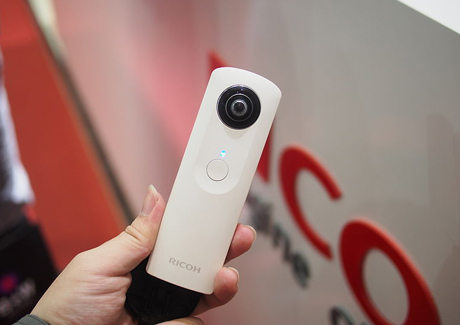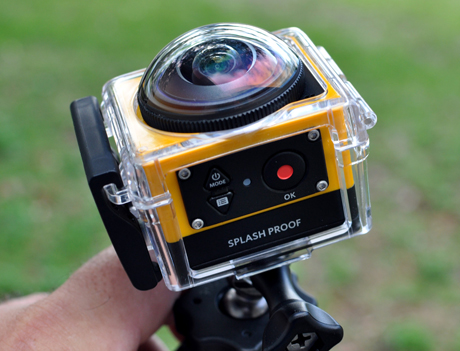
Video journalists across the world are now embracing virtual reality as a new way to engage audiences and encourage emotional connections between viewers and the people in their stories.
Just like computer-generated experiences and games, 360-degree video is a form of virtual reality – and many believe this can be used to expand and enhance traditional, narrative journalism.
The viewer is immersed in the story and can see everything happening around them, witnessing a real scene and experiencing what they can't first hand.
Just as news activist organisation Ryot recently took viewers into Syria's largest city with the 360-degree film Welcome to Aleppo, London-based company Immersiv.ly also aimed to demonstrate that virtual reality can be a powerful platform for news with Hong Kong Unrest, showing viewers last year's pro-democracy demonstrations in Hong Kong.
Interactive video specialist Edward Miller filmed and edited the footage for Hong Kong Unrest, and believes the progression of 360-degree video is inevitable for the future of news organisations.
"Platforms like Twitter and Facebook can offer instant news far quicker than larger media organisations can react. So I see news organisations moving towards the role of the analyst," he said.
"It's this progression towards 'slow news' and long form which I think will make content such as virtual reality a compelling way to provide extra value that users couldn't get anywhere else.
"Watching [Hong Kong Unrest] in a virtual reality headset gives the user a sense of what it was like to have been at the protests alongside police clashes, capturing small details that simply would have been missed with traditional fixed perspective cameras."
Creating a 360-degree video comes with its own challenges, but get the fundamentals right and you will avoid making any newbie mistakes.
Choose a suitable topic Not every story suits the format of 360-degree video; viewers must be able to benefit from the increased interactivity that virtual reality offers.
"I believe that the most powerful scenes that you can show in virtual reality are the ones which are recorded within the action itself," said Miller.
"Once a 360 degree camera operator places themselves within the social or personal space of the story's subjects, it's hard for the viewer not to empathise with what they are seeing" he added, noting this makes 360-degree format work best with either intimate and chaotic scenes.
Get the right equipment
- Camera
To create video for the virtual reality platform, you will need a compatible camera which is capable of filming 360-degree video.

Although Hong Kong Unrest was filmed on six GoPro cameras, there are more compact options available on the market, such as the Ricoh Theta M15 (available for £199) or the Kodak SP360 (£375) – both of which are compatible with YouTube.

However, Miller believes filmmakers will soon be looking for new technology to move away from action cameras, capturing scenes in higher resolution, with 3D 'stereoscopic' depth – so watch this space.
- Tripods/Boom poles
Whether you want to remove yourself from the frame, get up high to catch the action or just want a steady shot, you will need a sturdy tripod or boom pole.
Think about where you will be filming and the look you are trying to achieve in your footage. For example, Miller used a boom pole to support the cameras in Hong Kong Unrest in order to get them elevated above the crowd.
If you want to get adventurous, tripods such as the Joby Gorillapod Tripod (£13.50) are durable and allow you to wrap their legs around a variety of objects – perfect for shots in awkward positions or out of reach.
For a stand-alone tripod which is easy to set up yet strong enough to hold itself upright against the elements, check out styles such as the Manfrotto Compact Action Tripod (£59.95) – perfect for capturing the action in an instant without having to take too much time to assemble.
Boom poles are used for capturing footage up high and out of reach, and were used by Miller for Hong Kong Unrest. The RØDE 2m Micro Lightweight Boompole (£29.99) is great for those starting out in 360-degree filming. as it's light so you can get lots of practice to master the perfect angle for your 360-degree shot.
Re-think your filming techniques "
Filming in 360-degrees is practically much different from traditional video methods," said Miller. Video journalists traditionally use a combination of well-executed shots and expert editing to ensure a sense of a place is captured in their work.This luxury is removed in 360-degree video, and VJs must ensure they take this into account before going out on a shoot.
"For example, with a full 360-degree field of view, close-up shotsWe are effectively re-writing the rule book on the fundamentals of storytelling and what conventions work bestEdward Miller, interactive video specialist
don't make sense," said Miller, and the level at which you place your camera can have a "significant impact on how you perceive the shot – for example if you place the camera close to the floor, the viewer will feel miniaturised, like a Borrower".
If you are looking to conduct interviews within your 360-degree news package or film, Miller notes that you must be able to justify the value it would add to the footage. "I have seen a great documentary that interviewed a survivor of the 7/7 bombs," Miller said.
"The interview worked in that case because it was an incredibly emotional scene and it felt like you were confronted with the survivors pain. If it were just an interview at a conference for example, I don't think it would have the same effect."
Interviews within 360-degree videos will ultimately encourage the viewer to be intimately engaged with the people involved. "I guess it always relates back to who you are interviewing and what the emotion of the scene is," Miller said.
Editing your video
There are a variety of 360-degree editing tools on the market (known as 'video stitching software') which vary in price and differ in the files they support. Miller edited Hong Kong Unrest using a combination of specialist and traditional editing software.
"The six video streams were stitched together using a suite of products made by Kolor (now owned by GoPro) before being edited in Adobe Premiere, colour graded in Adobe After Effects, with some additional manual tweaks in a program called Blender," he said.
But 360-degree virtual reality videos are a relatively new concept in storytelling, and journalists are beginning to explore which guidelines work well and which don't.
"We are effectively re-writing the rule book on the fundamentals
of storytelling and what conventions work best. The best part about it is that we're still learning," said Miller.
Free daily newsletter
If you like our news and feature articles, you can sign up to receive our free daily (Mon-Fri) email newsletter (mobile friendly).
Related articles
- Newsrooms must step up their efforts to cover gender equality stories
- New project InOldNews wants to improve representation in video journalism
- 38 mojo apps from BBC trainer Marc Blank-Settle
- How to create viral news videos
- 10 ways news organisations are covering the anniversary of the Russia-Ukraine War









